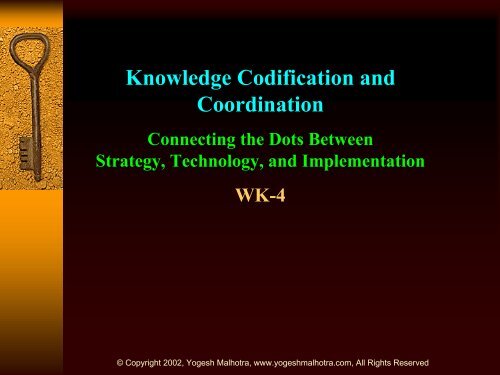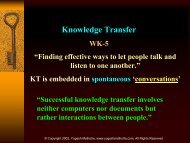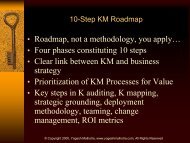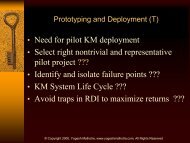Knowledge Codification and Coordination
Knowledge Codification and Coordination
Knowledge Codification and Coordination
Create successful ePaper yourself
Turn your PDF publications into a flip-book with our unique Google optimized e-Paper software.
<strong>Knowledge</strong> <strong>Codification</strong> <strong>and</strong><br />
<strong>Coordination</strong><br />
Connecting the Dots Between<br />
Strategy, Technology, <strong>and</strong> Implementation<br />
WK-4<br />
© Copyright 2002, Yogesh Malhotra, www.yogeshmalhotra.com, All Rights Reserved
The Three Components of <strong>Knowledge</strong><br />
Management:<br />
• <strong>Knowledge</strong> generation.<br />
Includes all activities, which brings to light knowledge<br />
that is "new" to the individual, to the group, <strong>and</strong> to<br />
the organization.<br />
• <strong>Knowledge</strong> codification.<br />
Representation of knowledge so that it can be "reused"<br />
either by an individual or an organization.<br />
• <strong>Knowledge</strong> transfer.<br />
“Movement of knowledge from one location to<br />
another”.<br />
© Copyright 2002, Yogesh Malhotra, www.yogeshmalhotra.com, All Rights Reserved
<strong>Knowledge</strong> Generation<br />
• Involves intentional activities of an organization<br />
– To acquire new knowledge<br />
– To create new knowledge<br />
• Techniques include<br />
– Buy or rent<br />
– Can hire ‘expert’ firm or individuals<br />
– Support external research, grants, consortia<br />
• Value of intellectual capital, “fair price”<br />
– How to keep ‘purchased knowledge’ intact<br />
– Differences in culture make hard to assimilate<br />
© Copyright 2002, Yogesh Malhotra, www.yogeshmalhotra.com, All Rights Reserved
<strong>Knowledge</strong> Generation<br />
– Research <strong>and</strong> Development<br />
• long time to get financial return<br />
• value depends on how effectively applied<br />
– Xerox – the problem child PARC<br />
• most knowledge generation from synthesis<br />
– combination of K from different sources<br />
– in unique ways<br />
• so that new ideas emerge<br />
© Copyright 2002, Yogesh Malhotra, www.yogeshmalhotra.com, All Rights Reserved
<strong>Knowledge</strong> Generation<br />
– Shared Problem Solving<br />
• Leveraging diversity of people<br />
• different backgrounds<br />
• different cognitive styles<br />
• creative solutions<br />
• experience can constrain search for novel ideas<br />
– “Creative abrasion”<br />
• people with diverse background<br />
• but a shared vision<br />
• come together to solve problems<br />
© Copyright 2002, Yogesh Malhotra, www.yogeshmalhotra.com, All Rights Reserved
<strong>Knowledge</strong> Generation<br />
• Adaptation<br />
– External <strong>and</strong> internal threats<br />
– Force need to generate new knowledge<br />
– Apply existing resources in innovative <strong>and</strong><br />
creative ways to rethink workflows, processes,<br />
business models<br />
– When core capabilities can become core<br />
rigidities<br />
– When best practices become worst practices<br />
© Copyright 2002, Yogesh Malhotra, www.yogeshmalhotra.com, All Rights Reserved
<strong>Knowledge</strong> Generation<br />
– Communities of Practice<br />
• Groups of workers who share common interests<br />
<strong>and</strong> objectives, but are not necessarily employed<br />
in the same dept/location (or firm), <strong>and</strong> who<br />
occupy different organizational roles<br />
• Bonded by a common sense of purpose<br />
• Shared interests in knowledge sharing<br />
• Collaboration for new knowledge creation<br />
• Collaborate F2F, or, by phone, by email <strong>and</strong> via<br />
online Internet/web communities<br />
© Copyright 2002, Yogesh Malhotra, www.yogeshmalhotra.com, All Rights Reserved
<strong>Knowledge</strong> Capture & <strong>Codification</strong><br />
• <strong>Knowledge</strong> generation needs to be channeled<br />
– Continuous processes of classifying,<br />
categorizing, scanning, filtering, organizing <strong>and</strong><br />
packaging knowledge<br />
– <strong>Codification</strong> is representation of K to make<br />
it easily accessible <strong>and</strong> transferable<br />
• <strong>Knowledge</strong> accumulates <strong>and</strong> changes over time<br />
<strong>and</strong> so it is hard to “measure” in discrete units<br />
• Subjective <strong>and</strong> Context sensitivity – DKI - <br />
• Capturing <strong>and</strong> Coding go h<strong>and</strong> in h<strong>and</strong> – What<br />
is not coded is not accessible nor transferable<br />
– D&P’s 4 basic principles for K codification<br />
© Copyright 2002, Yogesh Malhotra, www.yogeshmalhotra.com, All Rights Reserved
Overview<br />
<strong>Knowledge</strong> <strong>Codification</strong> <strong>and</strong> <strong>Coordination</strong><br />
“Relevance is far more important than completeness”<br />
• Tacit, explicit, codified, rich, poor<br />
• Categorize, describe, map, model, simulate<br />
• Principles of K <strong>Codification</strong><br />
– Business goals, importance<br />
– Identify Existing K <strong>and</strong> goals<br />
– Usefulness <strong>and</strong> appropriateness<br />
– Medium for codification <strong>and</strong> distribution<br />
© Copyright 2002, Yogesh Malhotra, www.yogeshmalhotra.com, All Rights Reserved
Codifying <strong>and</strong> Mapping<br />
Overview<br />
“Tacit, complex knowledge, developed <strong>and</strong> internalized<br />
by the knower [over a long period of time], is almost<br />
impossible to reproduce in a document or database.”<br />
• Tacit <strong>Knowledge</strong> – hitting baseball<br />
• Tacit experience – how to K transfer<br />
• <strong>Knowledge</strong> map – people, documents <strong>and</strong><br />
databases<br />
• K map is an inventory – HR skills etc<br />
• K – a piece in every head<br />
• Six Degrees of Separation<br />
© Copyright 2002, Yogesh Malhotra, www.yogeshmalhotra.com, All Rights Reserved
Case Studies of K Management<br />
“… Clearly the value of the map was the quality <strong>and</strong><br />
depth of information more than the bells <strong>and</strong> whistles<br />
of a sophisticated storage <strong>and</strong> retrieval system.”<br />
• Time Researchers – K pools<br />
• Microsoft’s Competencies <strong>and</strong> Training<br />
• Technologies for Mapping <strong>Knowledge</strong><br />
– Groove, Lotus Notes / Raven / Websphere,<br />
Peoplesoft, SAP, Restrac, Resumix<br />
• 33 1/3 % Rule – IT vs. K Projects<br />
• Politics of Mapping <strong>Knowledge</strong><br />
– Map vs. Territory<br />
• Dynamic modeling of <strong>Knowledge</strong><br />
© Copyright 2002, Yogesh Malhotra, www.yogeshmalhotra.com, All Rights Reserved<br />
Overview
Case Studies of K Management<br />
• Weick’s sensemaking <strong>and</strong> aerial<br />
photographs – AI versus meaning making<br />
• Embedded knowledge – M&A<br />
• Deep Blue – how deep<br />
• Expert systems <strong>and</strong> AI – promises <strong>and</strong> hype<br />
• Monsanto’s KM A – Tangible Patents as K<br />
• K Taxonomies<br />
Overview<br />
© Copyright 2002, Yogesh Malhotra, www.yogeshmalhotra.com, All Rights Reserved
<strong>Codification</strong><br />
• What is the purpose of knowledge codification<br />
– To convert corporate knowledge into accessible <strong>and</strong><br />
applicable formats<br />
– 4 basic principles:<br />
•What business goals are to be served<br />
•What knowledge exists in what form to accomplish the<br />
goals<br />
• How can it best be codified for usefulness<br />
• What is the appropriate medium for codification <strong>and</strong><br />
distribution<br />
© Copyright 2002, Yogesh Malhotra, www.yogeshmalhotra.com, All Rights Reserved
<strong>Knowledge</strong> capture <strong>and</strong> codification<br />
• Capturing involves scanning, organizing <strong>and</strong><br />
packaging knowledge<br />
• <strong>Codification</strong> is representing knowledge in a<br />
manner that can easily be accessed<br />
• Principles of knowledge codification<br />
– Define strategic intent<br />
– Identify existing knowledge<br />
– Evaluate existing knowledge for usefulness<br />
– Determine medium for codification <strong>and</strong> distribution<br />
© Copyright 2002, Yogesh Malhotra, www.yogeshmalhotra.com, All Rights Reserved
<strong>Knowledge</strong> Capture & <strong>Codification</strong><br />
• Defining Strategic Intent<br />
– Determine the business problem to be solved <strong>and</strong> align<br />
knowledge to be captured with business objectives<br />
• Identify & Evaluate Existing <strong>Knowledge</strong><br />
– Very difficult to determine knowledge requirements.<br />
– Subjective process raising political, cultural <strong>and</strong><br />
strategic issues.<br />
– Different perspectives about content needs, <strong>and</strong> sources<br />
of “hard” <strong>and</strong> “soft” information (e.g., ideas, gossip <strong>and</strong><br />
opinion).<br />
© Copyright 2002, Yogesh Malhotra, www.yogeshmalhotra.com, All Rights Reserved
<strong>Knowledge</strong> Capture & <strong>Codification</strong><br />
• Determining Appropriate Media<br />
– Media choice will vary with richness <strong>and</strong> complexity<br />
of the knowledge captured<br />
– Scanning: involves a combination of electronic <strong>and</strong><br />
human approaches, <strong>and</strong> is usually the first step in<br />
capturing knowledge<br />
– Involves capturing info, filtering out redundant info,<br />
adding value via human input;<br />
– a team can be tasked, with scanning news wires,<br />
broadcasts, etc. <strong>and</strong> synthesizing info into a daily<br />
report<br />
© Copyright 2002, Yogesh Malhotra, www.yogeshmalhotra.com, All Rights Reserved
<strong>Knowledge</strong> Capture & <strong>Codification</strong><br />
• Determining Appropriate Media<br />
– Organizing: structures info in an accessible form<br />
– Too much structure can hide info from employees<br />
whose mental models don’t match chosen structure –<br />
Andersen’s KXchange<br />
– Four classifications<br />
• Process knowledge (e.g., best practices) that can<br />
increase efficiency<br />
• Factual knowledge easily documented but of little<br />
value unless synthesized <strong>and</strong> in context<br />
• Catalog knowledge shows where things are –<br />
People yellow pages<br />
• Cultural knowledge - cultural <strong>and</strong> political<br />
© Copyright 2002, Yogesh Malhotra, www.yogeshmalhotra.com, All Rights Reserved
<strong>Knowledge</strong> Capture & <strong>Codification</strong><br />
• Determining Appropriate Media<br />
• <strong>Knowledge</strong> Maps<br />
– Guides to where knowledge exists in an organization <strong>and</strong><br />
an inventory of knowledge assets available<br />
– Several schemes to map knowledge<br />
• Physical mapping (IS architecture)<br />
• Qualitative mapping – points to information by topic<br />
rather than location<br />
• Process mapping – uses a generalized model of how<br />
a business functions to map knowledge<br />
• Functional mapping – loosely based on org. chart<br />
• Conceptual mapping – organize around objects,<br />
such as customers – hard to do<br />
© Copyright 2002, Yogesh Malhotra, www.yogeshmalhotra.com, All Rights Reserved
<strong>Knowledge</strong> Capture & <strong>Codification</strong><br />
• Codifying Tacit <strong>Knowledge</strong><br />
• Narratives<br />
– A way to try to capture the tacit knowledge of<br />
experts<br />
– A story can communicate ideas <strong>and</strong> complex<br />
underst<strong>and</strong>ing of events<br />
– When knowledge is shared in a context shared<br />
by listeners it is more likely to be absorbed<br />
– Videotapes provide one way to share stories<br />
easily<br />
© Copyright 2002, Yogesh Malhotra, www.yogeshmalhotra.com, All Rights Reserved
<strong>Knowledge</strong> Transfer<br />
• Four different modes of knowledge<br />
conversion<br />
– Socialization<br />
– Externalization<br />
– Combination<br />
– Internalization<br />
© Copyright 2002, Yogesh Malhotra, www.yogeshmalhotra.com, All Rights Reserved
Nonaka <strong>and</strong> Takeuchi (1995)<br />
Tacit to Tacit – Socialization<br />
Tacit to Explicit – Externalization<br />
Explicit to Explicit – Combination<br />
Explicit to Tacit - Internalization<br />
FROM<br />
Tacit<br />
Explicit<br />
Tacit<br />
Socialization<br />
Internalization<br />
Explicit<br />
Externalization<br />
Combination<br />
TO<br />
© Copyright 2002, Yogesh Malhotra, www.yogeshmalhotra.com, All Rights Reserved
<strong>Codification</strong><br />
• Gives structure & permanence to<br />
otherwise nebulous forms of knowledge<br />
– Pros <strong>and</strong> Cons<br />
– Distinctiveness & its value<br />
– Flexibility & adaptability to change – ‘Static’<br />
© Copyright 2002, Yogesh Malhotra, www.yogeshmalhotra.com, All Rights Reserved
Pros <strong>and</strong> Cons of <strong>Codification</strong><br />
• The more codifiable <strong>and</strong> teachable a capability is,<br />
the higher the risk of rapid transfer<br />
• High level of “Technological competition” <strong>and</strong><br />
fear of losing tech edge speeds transfer of<br />
capabilities.<br />
• Characteristics of the manufacturing capability do<br />
not affect hazard rate.<br />
• Imitation <strong>and</strong> transfer are not identical<br />
phenomena<br />
• Key Employee turnover is significantly associated<br />
with faster imitation time<br />
© Copyright 2002, Yogesh Malhotra, www.yogeshmalhotra.com, All Rights Reserved
<strong>Knowledge</strong> Generation <strong>and</strong> <strong>Codification</strong><br />
• <strong>Knowledge</strong> generation<br />
• <strong>Knowledge</strong> codification<br />
• <strong>Knowledge</strong> transfer - spirals<br />
• Tools<br />
– Data management tools- data warehouses, data search<br />
engines, data modeling, visualization<br />
– Information management tools - automated information<br />
search <strong>and</strong> retrieval agents, decision support<br />
technologies, executive information systems, document<br />
management technologies<br />
– <strong>Knowledge</strong> management<br />
© Copyright 2002, Yogesh Malhotra, www.yogeshmalhotra.com, All Rights Reserved








